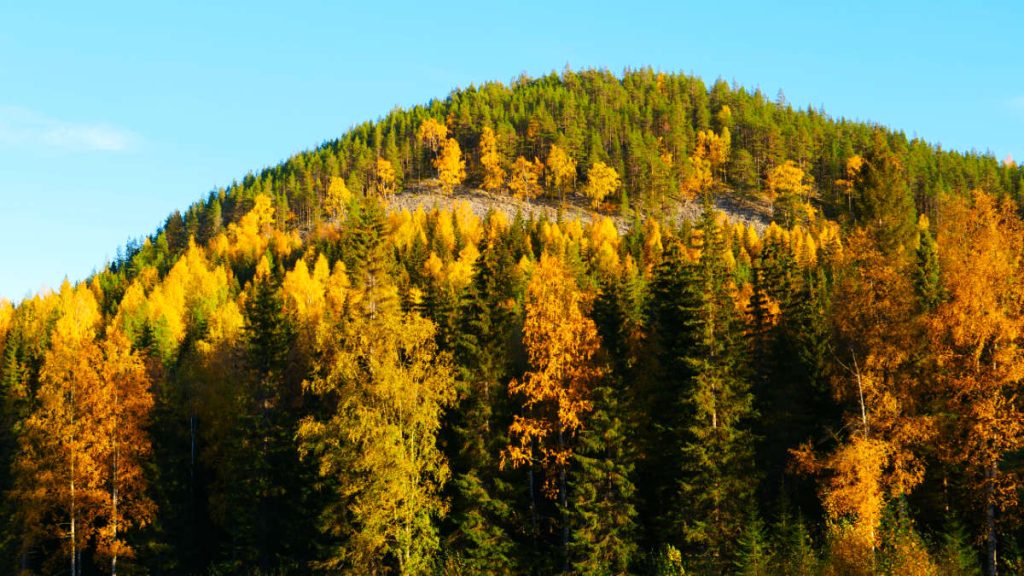Prästberget 1
Top of a magma chamber
Uphill on Mt Prästberget you are walking on a 1,500 million year old magma chamber. The chamber was formed of masses of molten rock, magmas that pushed upwards from deep within the earth and gathered a few kilometres below the earth´s surface. Since then all the material that had been above the chamber has weathered and eroded making it possible for you to look right into the chamber. This is unique to Ragunda.
Masses of molten rock became red granite and dark gabbro
Two melts pushed their way up here from deep within the earth at the same time but separately. The magmas were of completely contrasting compositions and so behaved in different ways.
When in due course the magmas cooled and became solid they formed rocks. One of the magmas was dark, almost black and became gabbro. The other one was red in colour and became granite.

Pulses of magma filled the chamber
Pulses of warm magma were continuously adding to the magma chamber from below. Magma that had already solidified could then heat up and become liquid again. The magmas interacted in batches, forming different patterns depending on whether they were liquid at the same time or not. Gabbro and granite melt at different temperatures. Gabbro is several hundred degrees warmer when melted compared to granite. The difference in temperatures between the two magmas meant that they would not fully blend everywhere.

Magma mingling – "pillows" of gabbro in granite
In many places you can see patterns of the gabbro in the granite, looking like pillows. This is called magma mingling and occurred at the time when both magma types were partially liquid at the same time.
The magmas may have been cold, hot or tepid at the time of the encounters. Around the gabbro you can sometimes spot a darker outer edge; this appeared when the warmer gabbro cooled off quicker in contact with the colder granite.

Rapakivi granite – a rare granite that crumbles easily
The rapakivi granite is odd in appearance. Scientists have different theories for this but there is no consensus. The rock is most often meaty red with large crystals and a yellow-white shell. The colour of the crystals and the shell stems from two kinds of the mineral feldspar. The semi-transparent, grey grains are the mineral quartz.
Rapakivi granite is quite rare in Sweden and nowhere else are you able to study the rock as well as in Ragunda.

Rapakivi means rotten or dirty stone
The word rapakivi is Finnish and refers to the two words ‘rapa’ meaning rotten or dirty, and ‘kivi’ that means stone or rock. The name refers to its character since rapakivi granite is easily worn down by water, wind and ice, it crumbles.
Cavities filled with large crystals
In the hill there are cavities filled with large crystals. The cavities were formed when hot magma rich in gases moved from deep within the earth up towards the earth´s surface. On the way the gases were released and formed bubbles, a bit like when you open a bottle of sparkling water. The bubbles contained various solutions of minerals depending on the composition of elements in the rock. As the magma cooled the bubbles were stabilised in the form of cavities. In the openings of the cavities the minerals grew at their own pace. Once they had hardened they formed large crystals. The more time they had to grow the larger the crystals became.

Weathering worns down rocks
Rock is continuously worn down by, for example, the sun, wind, and water, meaning that rock surfaces are in constant stage of change.
Here you can see traces of the weathering rock. In the border area where gabbro encounters granite you can see, in some places that the gabbro has abraded more than the granite. One reason for this difference is that the rocks contain minerals that weather more or less easily. Quartz is in general a mineral that does not weather easily.

Granite resistant to weathering
Granite contains much quartz which makes it more resistant to weathering compared to others such as gabbro. The exception is rapakivi granite where the texture and the fact that it contains a calcium-rich type of the mineral feldspar (plagioclase) which makes it more prone to weather.
More information
Sites to visit on Theme Continental Drift
More site photos



Places to visit nearby
Practicalities
Accessibility
See Accessibility.
Activities
Go hiking for one kilometre on a trail leading up on and around Mt Prästberget. A few hundred metres from the site is a picnic and barbecue place with scenic views over the River Indalsälven and the previous Lake Ragundasjön. See also Activities in Ragunda.
Eating and drinking
The nearest grocery store, café and eatery are in Hammarstrand. See also Eating and drinking in Ragunda
Accommodation
Missing on site, but various options are available nearby. See Accommodation in Ragunda.
Getting here
SWEREF 99 TM N: 6 997 752 E: 569 511
WGS84 N: 63,102476° E: 16,377218°



